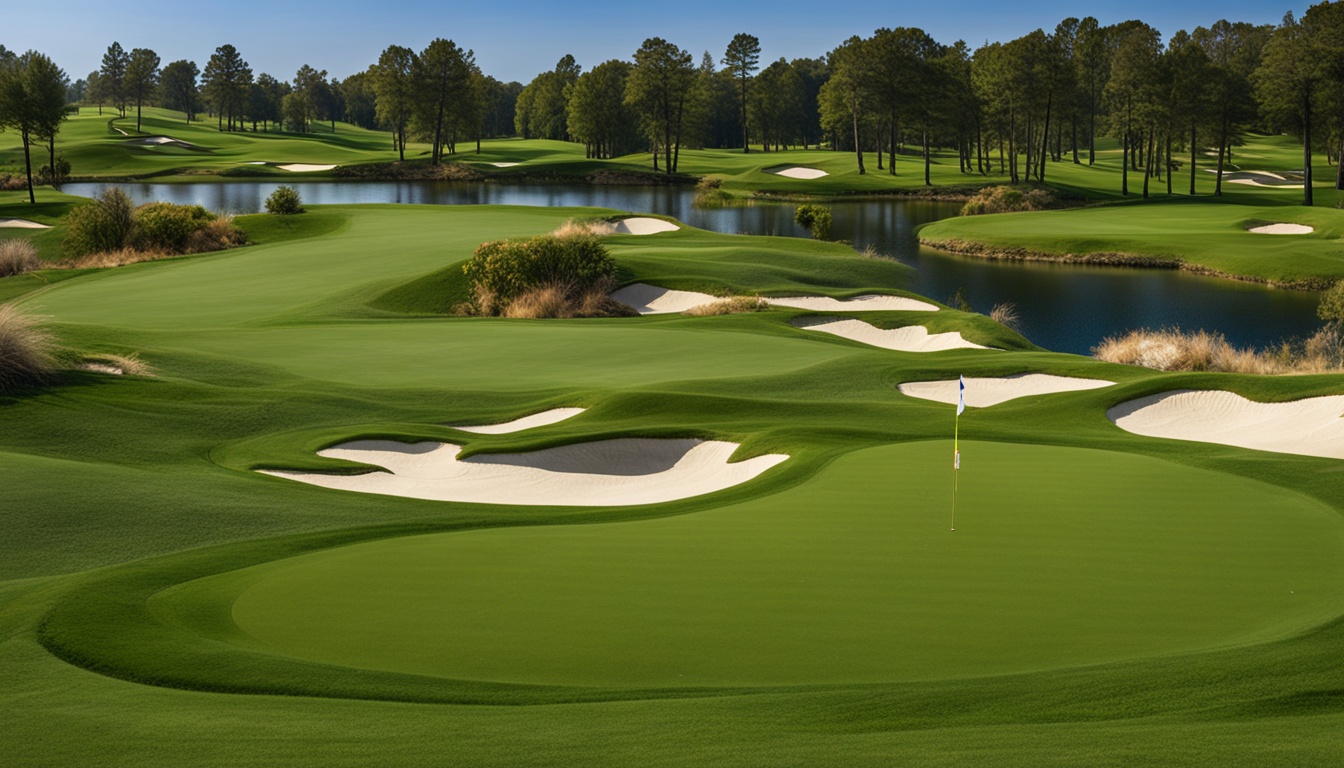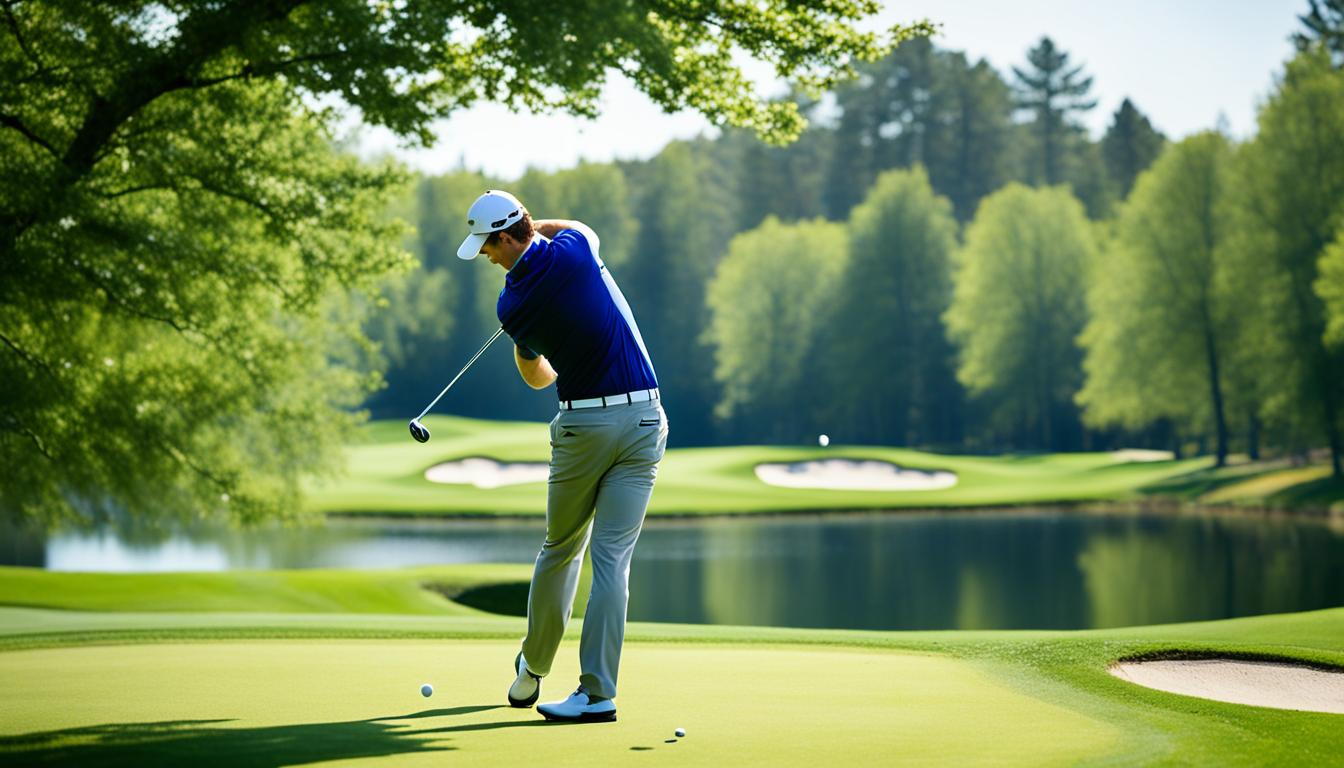Starting frisbee golf is like beginning traditional golf. Precision, strategy, and fun blend into this exciting sport. Our guide introduces you to frisbee golf, a lively sport. It replaces clubs with discs and holes with baskets. We’ll cover the main frisbee golf rules, disc golf techniques, and fair play principles in the frisbee game guidelines.
The goal is straightforward, mirroring the classic game: win by having the fewest throws at the end. Your discs turn into tools of strategy and skill, narrowing the path to victory with each throw. As skills grow, safety and respect guard every move, ensuring a fun and fair competition for all.
Understanding the Basics of Frisbee Golf
Starting out in frisbee golf means learning core concepts of this exciting sport. Like in golf, players aim to finish with the least throws, sticking to disc golf regulations. They also respect frisbee sports etiquette.
The game kicks off at the tee area, where the first throw is made. Here, players plot their strategy on placement and throw force. This moment shapes the game’s flow. It’s also when they start following the rules and showing respect for other players.
Good frisbee sports etiquette is about more than rules. It ensures everyone has a great time. Players should keep a safe distance from others and let the person furthest from the hole throw next. This keeps the game fair and friendly.
| Element | Description | Importance |
|---|---|---|
| Proper Foot Placement | During a throw, players must position their feet correctly, especially near the target. | This provides balance and accuracy, helping avoid penalties like the falling putt infraction. |
| Out of Bounds (O.B.) | Throws landing out of bounds bring penalties. Play continues from a point within 1 meter from where the disc left play. | Focus on accuracy and adhere to the course’s boundaries, influencing strategy and style. |
| Mandatory Routes | Paths marked by obstacles must be followed to dodge penalties. | It tests the player’s skill and understanding of the disc throwing course layout. |
| Equipment | Includes different discs for driving, midrange, and putting, each for various game phases. | Choosing the right disc can optimize throw distance and flight path. |
Heeding these key guidelines and rules assures safety and fun for everyone. Playing frisbee golf, whether competitively or for fun, becomes rewarding when embracing its spirit. This is achieved through practice and fair play.
Frisbee Golf Rules and Regulations
For both new and seasoned players, knowing the frisbee golf rules is crucial. These rules make the game fair and more fun on the disc golf course layout. A key rule is about having the least total strokes wins the game. This highlights skill and planning over just hitting far.
Every round starts with throws from the tee area. They must be done within or right behind this area. The next throw’s order comes from the scores on the last hole. The player with fewer strokes goes first. When close to the target, within 10 meters, players must stay still after throwing. They can’t move past where their disc landed until it stops. This makes shots from up close more challenging and skillful.
If a throw goes out of bounds, the player resumes the game from a point up to 1 meter inside where it left the play area. This rule from the frisbee tournament rules gives a penalty for bad throws. Yet, it lets the game go on.
Frisbee golf stresses sticking to set paths, named “mandos”. Missing these or landing out of bounds results in penalties. These strict rules force players to think before each throw. In situations with unplayable lies or dangers, moving the lie a bit without penalty is allowed. This is for safety and fairness.
| Rule | Description | Penalty for Non-Adherence |
|---|---|---|
| Mandatory Paths (“Mandos”) | Specific paths a disc must travel | Stroke penalty for missing the path |
| Out of Bounds | Disc lands outside designated play area | Continue play from up to 1 meter inside the line where disc went out |
| Unplayable Lie | Disc lands in an unplayable position | Relocate lie without penalty, maintaining overall game fairness |
Also, keeping the course in good shape and sticking to the frisbee golf rules by the Professional Disc Golf Association matters a lot. This means throwing away trash correctly and caring for the course’s natural and man-made features. It shows we respect other players and the environment. The sport grows thanks to a culture of respect, fair play, and a love for outdoor gaming.
Initiating Play: Tee Throws and Lie
Learning the basics of tee throws is key for anyone into frisbee golf. A tee throw happens in a special spot at the start of each hole. It’s very important because it lays the groundwork for your game. It shows how a well-made disc golf course design can influence how well you play.
Where your disc lands after that first throw is called the ‘lie.’ It’s where your next throw starts from. To keep score right in frisbee golf scoring, you either leave the disc there or use a mini marker disc. This rule makes sure every player throws from the right spot.
- Course Navigation: Good tee throws consider the disc golf course design. They aim to avoid out-of-bounds areas which can lead to penalties and hurt your score.
- Strategic Play: Where your lie is affects how you throw next. It’s key for getting past obstacles and reaching the basket with fewer throws.
Here’s a table that shows how tee throws, lie marking, and scoring tie together:
| Aspect | Impact on Game |
|---|---|
| Accuracy of Tee Throws | Makes the next shot easier, which can mean fewer throws in total. |
| Proper Marking of Lie | Keeps the game fair and by the rules, boosting player confidence and strategies. |
| Effect on Scoring | There’s a direct link to how many strokes you take; better control equals better scores. |
Getting to know these elements not only boosts your performance but also grows your love for the game’s strategy and the thought behind disc golf course designs.
Navigating the Disc Golf Course Layout
Getting good at disc golf techniques is key to doing well in disc golf course layout. These techniques shape how well a player does and how they see the game. Knowing how to deal with mandatory paths, like certain trees or obstacles, is important. If you don’t get it right, you might get penalties that change the game’s result.
Doing well with mandatory paths means you need to throw carefully and plan ahead. The path you pick doesn’t just affect your score right then. It also impacts how you do on the rest of the course. Figuring out how to handle different layouts and challenges is what makes disc golf fun and rewarding.
Below is a table showing different challenges and what happens if you don’t follow the rules about mandatory paths and other course rules:
| Challenge | Penalty | Description |
|---|---|---|
| Mandatory Paths | 1-throw penalty | Failure to navigate the disc on the correct side of a mando results in a penalty, requiring a throw from the previous lie or a designated drop zone. |
| Out of Bounds | 1-throw penalty | If any part of the disc touches the out-of-bounds line, the disc is considered out, and the player must throw from up to 1 meter inside the bounds line. |
| Unplayable Lie | 1-throw penalty | A disc resting above the ground at more than 2 meters is considered unplayable, and a throw must be made from directly underneath. |
| Water Hazards | 1-throw penalty | Discs landing in water are considered out-of-bounds, necessitating a penalty throw. |
With practice and seeing lots of disc golf course layouts, players learn to spot the best paths and how to adjust their throws. Knowing the disc golf techniques for getting past obstacles helps cut down on penalties and get better scores. So, knowing your way around the course is super important in disc golf.
Proceeding Through the Game: Order and Etiquette
Knowing the throwing order is crucial in disc golf. It helps the game stay structured and fair. The player who did the best on the last hole gets to throw first. This keeps the game moving smoothly and keeps everyone involved.
Frisbee sports etiquette is very important for a great game experience. It’s about being quiet when someone is throwing and not causing distractions. Players should cheer for good throws and give tips only when asked. This shows great sportsmanship.
Here’s how disc golf regulations keep the sport fair and honest:
- Don’t change the course to your advantage (e.g., breaking branches).
- Take care of the course by respecting both natural and man-made features.
- Remember, throwing trash on the course is not allowed. We must keep it clean for everyone.
Following these rules and etiquette improves your game and everyone’s experience. It helps the game stay respected and enjoyable for a long time. It’s important for everyone to work together to keep the sport fun and respectful.
The mix of throwing order, frisbee sports etiquette, and disc golf regulations makes the sport fun, fair, and competitive. If every player cares and cooperates, the game’s atmosphere will be welcoming and positive.
Frisbee Golf Scoring Mechanics
For both new players and pros, understanding frisbee golf scoring is key. The main rule is simple: the one with fewer throws wins. Each throw counts as a stroke and getting this right is vital for fun and competitive play.
Disc golf regulations make scoring fair and right. Penalties add extra strokes, like when a disc lands out of bounds. These penalties can really change a player’s score, making them a big part of the game rules.
Every hole in disc golf brings a new test, starting with the tee throw. Players must tee off correctly, following the rules. For throws not on the tee, the next throw is right behind where the last one landed. This is unless you’re within 10 meters of the goal. Then, players must not step past their marker, adding strategy to the game.
Now, let’s go over some standard scoring terms:
- Par: what an expert should score on a hole.
- Birdie: scoring one less than par.
- Eagle: two under par.
- Ace: getting the disc in the hole on the first throw.
- Bogey: one above par.
In frisbee tournaments, keeping accurate scores is a must. Since 2024, the PDGA demands players or their caddies keep score. This means scores must be recorded right and submitted quickly, usually within 30 minutes after finishing. Friendly games are less strict, focusing more on fun than precise scores.
Players can use paper scorecards or apps like Infinite Disc Golf and Udisc for scoring. These tools keep scores accurate and easy to access.
The clear rules and scoring in disc golf make it more fun and competitive. They let players of any level see how they are improving and enjoy the game more over time.
Honing Your Disc Golf Techniques
To get better at disc golf techniques, it’s key to work hard. This matters whether you’re practicing or competing with strict frisbee golf rules. Learning about grip, stance, and how to throw a disc right can really up your game.
Starting with the grip is important. Put four fingers under the disc and the thumb on top. This grip helps you control the disc’s angle and speed when you throw it.
The stance is next. It’s vital for good momentum. Stand parallel to your target, feet apart, to keep balance and aim right when you throw.
Throwing the disc involves a few steps. These include:
- Twisting your body to build up energy.
- Untwisting smoothly to turn that energy into motion as you let go of the disc.
- Making sure the disc is flat and even to fly straight to where you’re aiming.
Getting these basics right is part of a bigger disc throwing course plan. It’s not just about distance. It’s also about placing your disc well, thinking about the baskets and the field.
Following the frisbee golf rules when you practice is also smart. It gets you ready for all kinds of games, from casual to serious competitions. Obeying the rules about where to place your disc and how to act makes big matches feel easier.
Working hard on your disc golf skills helps a lot. Not only does it make you better at throws, but it also makes you enjoy the game more.
Choosing the Right Equipment: Discs and Baskets
It’s vital to pick the right disc golf discs and disc golf baskets to follow frisbee game guidelines. The type of disc and basket you choose greatly impacts your game. They play key roles in how you score and play.
Understanding the disc’s speed, glide, turn, and fade is key. Speed tells you how far a disc can go. For example, putters have a slow speed, perfect for short distances. Drivers, however, have high speeds for longer shots.
Glide affects how long a disc stays in the air. The Escape, with high glide, travels far with less effort. The Felon, with lower glide, offers more control for short plays.
- Turn influences the disc’s left or right movement. A disc like the Warrant curves right, good for avoiding obstacles.
- Fade determines the disc’s left turn at the end of its flight. High fade discs are stable in wind.
Disc golf baskets mark the end goal in disc golf. They come in styles like portable or fixed. The type of basket can change how a game is played. Some baskets have wide chains, helping to catch the discs better.
| Disc Type | Speed | Glide | Turn | Fade |
|---|---|---|---|---|
| Putter | 2-3 | Medium | Low | Low |
| Midrange | 4-6 | High | Medium | Medium |
| Fairway Driver | 7-9 | High | Varied | High |
| Distance Driver | 10+ | Very High | Varied | Very High |
Choosing the right equipment means matching the disc and basket to your play style and the course. It’s a key strategy to stick to frisbee game guidelines. And it boosts your chances to win.
Conclusion
Disc golf is a sport with a rich essence, stretching beyond just the frisbee golf rules. It includes a deep respect for game etiquette and disc golf strategies. The game also follows structured tournament rules tightly. In the United States, there are over 7,500 courses. Since 1976, the Professional Disc Golf Association has grown to more than 100,000 members. This community supports over 3,500 sanctioned tournaments every year. This growth highlights the sport’s charm and competitive spirit.
The game attracts many with its diverse courses and the variety of discs and gear that improve performance. Players invest in quality equipment and practice techniques like the “hyzer” and “anhyzer.” They also follow a “pack in, pack out” ethic. Moreover, updates to the Official Rules of Disc Golf address new challenges. These include moving obstacles and scorekeeping integrity. These changes help the sport evolve alongside player experiences.
Disc golf’s popularity reflects the strength of its community and a commitment to fair play. The sport fosters a spirit of inclusivity and continuous improvement. Players take care of their equipment and value tournament camaraderie. Disc golf represents the joy of playing, the excitement of competition, and a strong bond among participants. It’s more than just a game; it’s a celebration of dynamic sportsmanship.
### FAQ
#### Q: What are the basic frisbee golf rules for beginners?
A: For new players, start by throwing from the tee area. Then, throw again from where your disc lands. Aim to finish each hole with the least throws possible. Follow the game’s safety rules and be polite to others in the park.
#### Q: Can you explain the important aspects of frisbee sports etiquette?
A: Good manners in frisbee sports include playing in turn based on the last hole’s scores. Don’t throw until it’s safe. Be quiet and still when others throw.
#### Q: How do tee throws and lies work in disc golf?
A: Your first throw on a hole, the tee throw, is from a special area. Where the disc lands is where you throw next, called the lie. You mark the lie with a mini disc or by leaving the thrown disc.
#### Q: What are mandatory paths and how do they affect gameplay?
A: “Mandos” are routes you must take around things like trees. Missing a mando means you get a penalty. You might have to re-throw or add a penalty to your score, depending on the rules.
#### Q: What is the proper order of throws in disc golf?
A: Who throws first depends on scores from the last hole; lowest goes first. During a hole, if your disc is farthest, you throw next. This keeps the game fair.
#### Q: How is scoring done in frisbee golf?
A: Scoring is by counting throws like in golf, aiming for the fewest. Throws equal strokes. Penalties increase your score. The total score is all hole scores added together.
#### Q: What techniques can I use to improve my disc golf game?
A: Improve by focusing on grip, stance, and throw types. Practice backhands, forehands, and adjusting for windy conditions. Getting better at putting, approaching, and driving lowers your score.
#### Q: What should I consider when selecting discs and baskets for disc golf?
A: Choose discs by their weight, shape, and purpose—drivers for long distances, mid-ranges for control, putters for accuracy. Pick baskets based on durability and design, suitable for your play level.


